Rattan Chairs: A Blend of Aesthetics, Nature, and Comfort
The Popularity of Rattan Chairs in the World of Interior Design and Furniture
In recent years, rattan chairs have regained popularity in the world of interior design and furniture. This is not only due to their classic, natural appearance, but also their adaptability to a variety of decor styles—from traditional to modern minimalist. They are no longer considered old-fashioned; instead, they have become a symbol of a lifestyle that is environmentally conscious, aesthetic, and functional.
The Attraction of Rattan as a Flexible and Environmentally Friendly Natural Material
Rattan is a natural material derived from a vine in the palm family, and thrives in Indonesia's tropical forests. One of rattan's advantages is its flexibility and strength, making it ideal for weaving into unique furniture shapes, such as chairs. Furthermore, rattan is a renewable resource, making it far more environmentally friendly than synthetic materials or slower-growing hardwoods. This makes rattan a prime choice for consumers concerned about sustainability.
The Trend of Using Rattan Chairs in Modern Homes, Cafes, Resorts, and Workspaces
Design is evolving to meet current tastes. Many modern homes are adopting rattan chairs as a refreshing element, bringing a natural feel to the predominantly industrial materials. In cafes and restaurants, they create a relaxed and Instagrammable atmosphere. Even in casual workspaces or offices, they are starting to be included as a furniture choice for their aesthetics and comfort. Unsurprisingly, demand continues to rise both domestically and internationally.
What Is Rattan and Why Is It Chosen for Furniture?
1. A Brief Explanation of Rattan
Rattan is a climbing plant from the palm family (Arecaceae) that thrives in the tropical forests of Southeast Asia, particularly Indonesia, the world's largest rattan producer. Unlike ordinary trees, rattan grows long and flexible, with a dense, cylindrical stem and a segmented surface. It can grow tens of meters long, making it an ideal material for weaving or shaping into various products, particularly furniture.
2. The Advantages of Rattan as a Furniture Material
Rattan is often chosen as a furniture material because it has a number of natural advantages, including:
- Lightweight, easy to move and rearrange
- Strong and durable if processed properly
- Flexible, easy to shape into unique and ergonomic designs
- Aesthetic, with charming natural colors and textures
- Environmentally friendly, because rattan grows quickly and is easily renewable compared to hardwood.
Because of these characteristics, rattan is often used as the main material for chairs, tables, shelves, and home decorations.
3. Differences between Natural Rattan and Synthetic Rattan
- Natural rattan:
- Made directly from rattan plants
- Has a natural texture and color (brownish yellow, cream, or white)
- Needs extra care to prevent rotting due to moisture or termites
- More artistic and traditional value
- Synthetic rattan:
- Made of plastic (usually PE or PVC)
- More weather resistant and suitable for outdoor use
- Available in various colors and easier to clean
- Often combined with an aluminum or iron frame
Types of Rattan Chairs
Rattan chairs come in a variety of shapes, designs, and materials. Rattan's versatility as a material allows it to be used for a variety of furniture needs, both indoors and outdoors, and in commercial settings.
A. Based on Form & Function
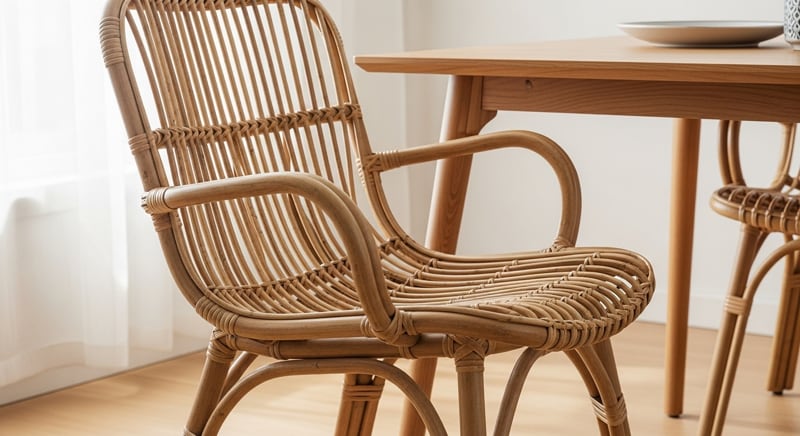
1. Rattan Dining Chairs
Designed with ergonomic dimensions and typically without thick cushions for practical use at the dining table, rattan dining chairs are perfect for adding a warm and natural feel to dining spaces, whether in minimalist, rustic, or tropical designs.
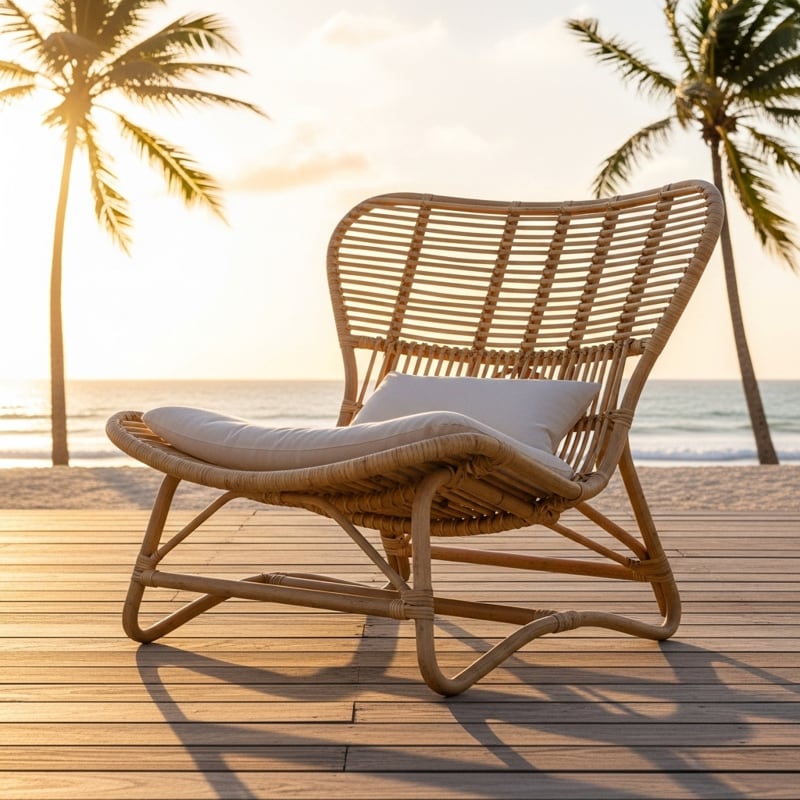
2. Lounge Chair
Typically featuring a low to medium backrest, and sometimes armrests. Designed for relaxation, rattan lounge chairs are often used in living rooms, patios, balconies, or reading areas.

3. Kursi Ayun / Gantung (Hanging Chair)
This chair is designed to be hung from the ceiling or suspended from a support pole. Also known as an "egg chair," this style is popular in semi-outdoor spaces and cafes due to its unique and Instagrammable shape.
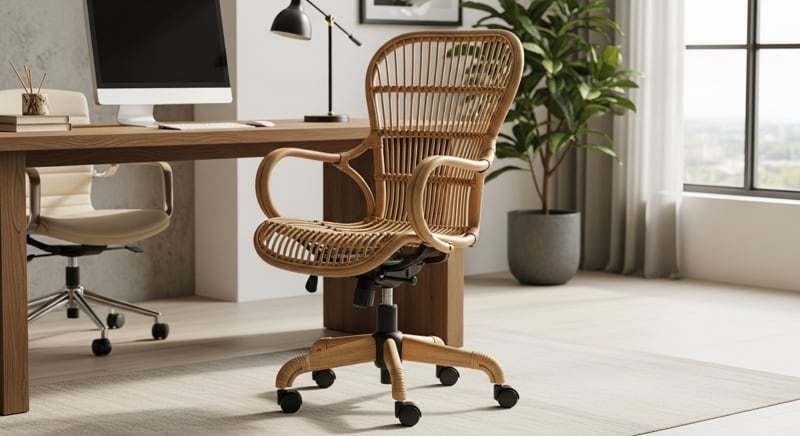
4. Rattan Work / Office Chair
Combining aesthetics and functionality, rattan chairs now also come in work styles—with ergonomic shapes, cushioned seats, and sturdy frames. They're perfect for casual or natural workspaces.
B. Based on the manufacturing materials
1. Natural Rattan
Made from genuine rattan, it's suitable for indoor use. It creates a warm, elegant, and artistic feel. However, it requires extra care to prevent moisture and termite infestation.
2. Synthetic Rattan (Plastic/PE)
Made of water- and weather-resistant polyethylene (PE) plastic. Ideal for outdoor furniture such as gardens, balconies, or open-air restaurants. Available in a variety of colors and easy to clean.
3. Rattan and Wood/Iron Combination
Kursi rotan modern sering menggabungkan rotan sebagai material utama dengan rangka kayu (memberi kesan hangat alami) atau besi (industrial and robust appearance). This combination creates a more durable and attractive design for contemporary interior styles.
Rattan Chair Design & Aesthetics
Rattan chairs serve not only as seating but also as decorative elements that enhance the feel of a space. The design and aesthetic of rattan chairs are highly flexible and can adapt to a variety of interior styles.
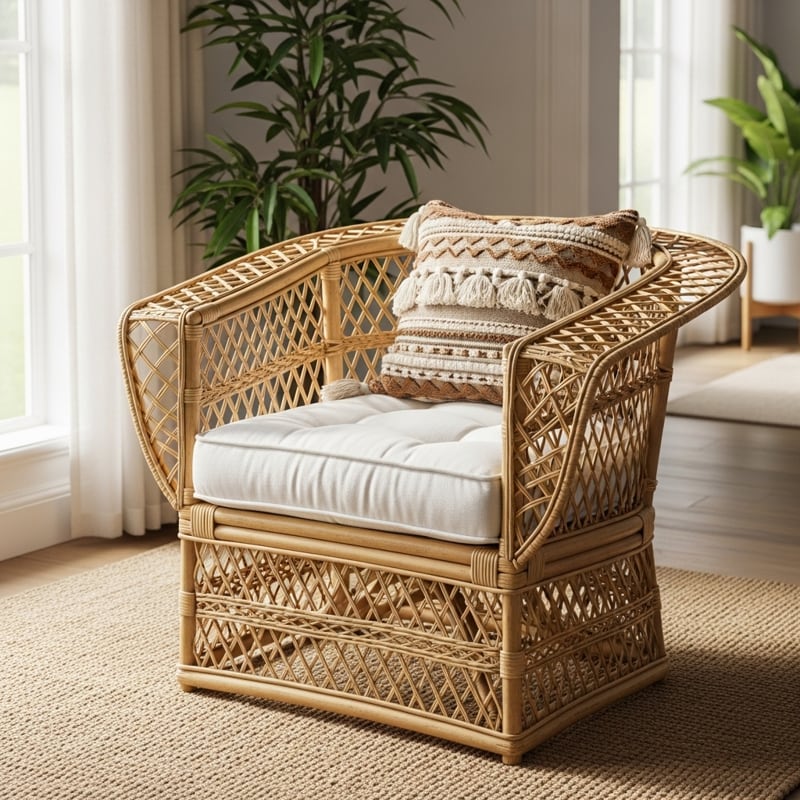
1. Popular Design Styles
Rattan chairs are suitable for various interior design styles, including:
- Bohemian
Rattan chairs are a staple in boho style—combined with ethnic-patterned rugs, ornamental plants, and a variety of fabric textures. The chair's shape tends to be free-form and artistic. - Skandinavia
Minimalist designs feature neutral colors like white, cream, and gray. Rattan chairs in this style are typically simple and functional, often combined with light wood. - Tropis
Bringing a warm and fresh natural feel, tropical rattan chairs are often placed near large windows or gardens, combining green with wooden furniture. - Rustic
Emphasizing a natural and traditional feel, rustic rattan chairs are typically unpainted, retaining the rattan's natural color with a rough, authentic texture.
2. Color and Finish of Rattan Chairs
The color of the rattan chair plays a big role in determining the visual impression and harmony with the space:
- Natural: the cream or pale yellow color of real rattan, gives a warm and earthy impression.
- White: perfect for shabby chic or coastal looks.
- Black: looks elegant and contrasting, often chosen for modern minimalist designs.
- Dark brown: gives a classic and luxurious impression.
Finishing can include a clear coating to preserve the natural color, or a solid paint for a more modern look. There are also wash techniques (whitewash or greywash) that create a vintage effect.
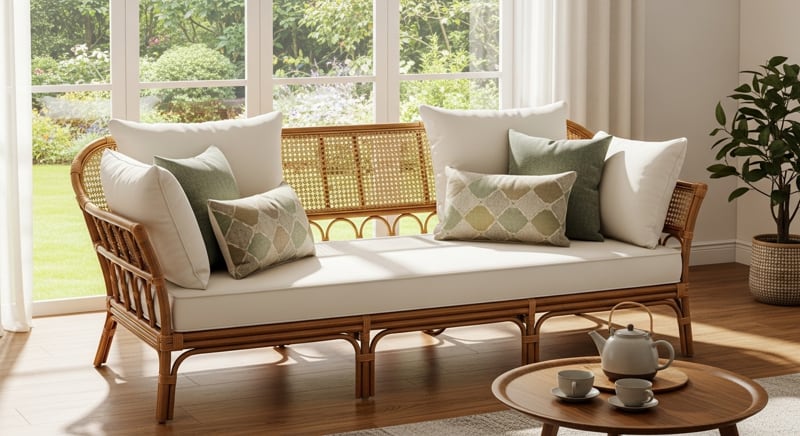
3. Combination with Cushion and Accessories
To make it more comfortable and visually appealing, it is often combined with:
-
- Cushions (seat or back cushions) with soft colors or ethnic/tropical motifs.
- Throw blanket for a cozy feel, perfect for a reading room or bedroom.
- Ornamental plants around the chair as a complement to the natural style.
- This combination makes it not only functional, but also creates a lively, warm, and aesthetic atmosphere in the room.
Kelebihan dan Kekurangan
Rattan chairs are an increasingly popular furniture choice due to their natural appearance and versatility in various spaces. However, like any other furniture, they have their own advantages and challenges.
Advantages of Rattan Chairs
-
- Aesthetic and Visually Attractive
It has a warm, natural, and artistic appearance. Its distinctive woven texture adds a unique decorative touch, suitable for a variety of interior styles, including bohemian, rustic, tropical, and modern. - Lightweight and Easy to Move
Compared to wood or metal furniture, it's much lighter. This makes it practical to rearrange or move from one room to another, including for indoor and semi-outdoor use, such as on a terrace or balcony. - Environmentally friendly
Rattan is a fast-growing, renewable natural material, making it a more sustainable alternative to hardwood. Its production process generally involves fewer chemicals and has a lower carbon footprint. - Suitable for Indoor and Semi-Outdoor
Rattan chairs, especially synthetic ones, are ideal for both indoor and outdoor use in protected spaces. They're perfect for living rooms, dining rooms, gardens, and even cafes or hotels.
- Aesthetic and Visually Attractive
Kekurangan Kursi Rotan
- Vulnerable to Moisture (Natural Rattan Only)
Natural rattan is less resistant to water exposure and high humidity. If stored in a damp environment, it can easily develop mold, warp, or even rot. Therefore, extreme care is needed when using it outdoors. - Needs Special Care
Rattan chairs require regular maintenance to maintain their longevity. This includes removing dust from between the weaves, protecting them from direct sunlight or rain, and periodically applying a protective coating such as a coating or varnish.
Tips for Choosing and Caring for Rattan Chairs
To ensure your rattan chair remains beautiful, comfortable, and long-lasting, it's important to know how to choose a quality product and how to care for it. Here's a practical guide you can use:
A. How to choose a quality rattan chair
- Check Frame Strength
Choose one with a sturdy frame—usually made of hardwood (such as mahogany or teak) or iron. Make sure it won't wobble when you sit on it, and that the joints between the frames are strong and neat. - Observe the Density of the Weave
Anyaman Quality rattan looks neat, solid, and doesn't come loose or rip easily. Avoid chairs with loose weaves or protruding threads, as these indicate imprecise workmanship. - Check the Finish and Color. Rattan chairs should have a protective coating (such as a clear coat or waterproof paint) to extend their lifespan. A smooth, even finish indicates professional workmanship.
B. Tips for Caring for Rattan Chairs
- Avoid Direct Exposure to Water
Do not place this chair in an area exposed to direct rain or standing water. Use this chair in a shaded indoor or semi-outdoor area. - Wipe Regularly and Dry Well
Clean the chair from dust using a dry cloth or soft brush regularly. If it comes into contact with water, wipe it down immediately and dry it in a shady place to remove moisture and prevent mold. - Use Additional Coatings
Reapply an anti-fungal coating or varnish every few months for extra protection, especially if the chair is frequently used in open areas.
C. How to Store So It Doesn't Quickly Become Brittle or Moldy
-
-
- Store in a dry, well-ventilated area, away from damp walls or wet floors.
- Don't stack them for too long without air circulation, because they can become flat and moldy.
- If not used for a long time, cover it with a breathable cloth (not plastic) to prevent dust from sticking and to keep the humidity stable.
-
Rattan Chairs in the Export Industry
Rattan chairs are not only popular domestically as highly aesthetic furniture, but they are also one of Indonesia's leading products in the international market. Beyond their beauty, rattan chairs hold significant economic value and involve millions of small and medium-sized businesses.
1. Rattan Production Centers in Indonesia
Indonesia is one of the world's largest producers and exporters of rattan. Some of the regions that are centers of the rattan craft industry include:
-
-
- Cirebon (Jawa Barat)
Known as Indonesia's largest rattan industrial center, Cirebon boasts a complete production chain, from raw materials to finished products ready for export. - Sulawesi Selatan dan Sulawesi Tengah
This area is the main source of raw rattan and is also home to many local craftsmen who still maintain traditional techniques. - Kalimantan Tengah dan Kalimantan Selatan
The natural rattan forest area is also starting to develop into a center for the processed rattan industry.
- Cirebon (Jawa Barat)
-
2. Export Potential and International Markets
Indonesian products have high appeal in the global market due to their natural appearance, handcrafted quality, and diverse designs. The main export destinations for rattan chairs include:
-
-
- Amerika Serikat
- Negara-negara Eropa (Belanda, Jerman, Prancis)
- Australia
- Jepang
- Korea Selatan
-
The global trend toward eco-friendly lifestyles and natural furniture is driving demand for Indonesian-made rattan chairs. Synthetic rattan products are also gaining popularity due to their increased durability for the outdoor market.
3. The Role of MSMEs and Local Craftsmen
UMKM dan pengrajin lokal memainkan peran penting dalam menjaga keberlanjutan industri :
-
-
- They maintain their expertise in processing and weaving rattan manually.
- Home industries create jobs for rural and small town communities.
- MSMEs have become a significant driver of non-oil and gas exports, particularly through partnerships with large exporters and cooperatives.
-
With support from design training, digital promotion, and funding from the government and private sector, rattan MSMEs in Indonesia have a great opportunity to continue growing and competing globally.
Closing
Rattan chairs are more than just furniture, but rather a lifestyle that emphasizes natural beauty, comfort, and sustainability. With their aesthetic forms and eco-friendly base materials, they reflect a blend of traditional heritage and modern design trends.
Let's support local rattan products—the work of Indonesian artisans—as a token of appreciation for local wisdom and a tangible contribution to environmental sustainability. By choosing and caring for rattan chairs, we contribute to preserving the ecosystem, strengthening the regional creative economy, and introducing the beauty of Indonesian rattan to the world.
